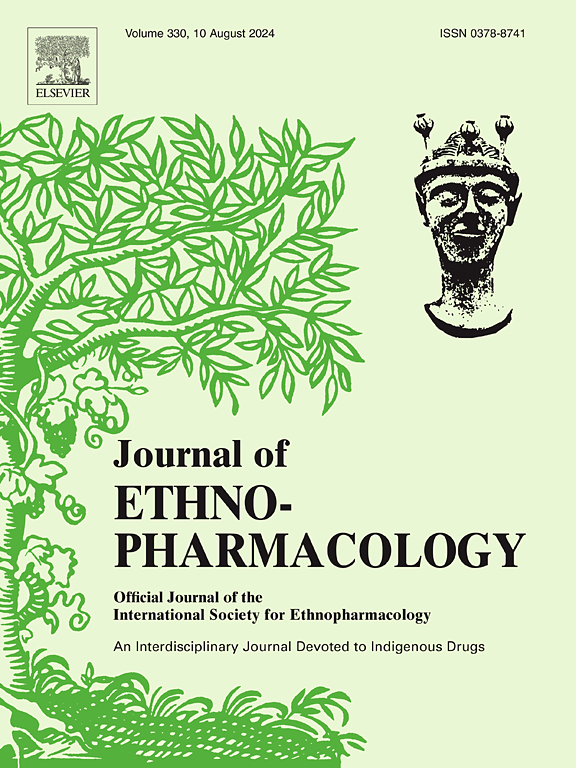基于表征、多组分定量和药代动力学的泻白散汤对粳稻的亲和性研究
IF 4.8
2区 医学
Q1 CHEMISTRY, MEDICINAL
引用次数: 0
摘要
民族药理学相关性泻泻百散汤(XBS)是一种治疗肺热咳嗽的有效中药,由四种中药组成:桑白皮、枸杞皮、甘草和粳米。XBS的原方及其修改方在临床应用中得到了极大的扩展。然而,粳稻作为一种先导药物往往被忽视,其对体内成分和代谢的影响尚未得到充分的研究。本研究的目的是解释粳稻在XBS中的亲和性。本研究通过比较不加粳稻汤剂(XBS- jm)的物理状态,并测定XBS和XBS- jm煎液中26种指示成分的含量,说明粳稻对煎煮过程中各成分整体物理状态和溶出度的影响。结合18种有效成分经血液吸收后的药动学特征分析,全面探讨了粳稻的作用及处方配伍的科学依据。方法建立灵敏可靠的UPLC-Q-TOF-MS定性分析方法,对XBS进行化学成分分析。以汤剂剩余体积变化为指标,选择煎煮时间30min、50min、90min。利用马尔文粒度仪和透射电子显微镜(TEM)研究了粳稻对相态的影响。建立高选择性、高灵敏度的UPLC-MS/MS定量分析方法,检测三种不同煎煮时间煎液中26种化学成分的含量变化。同时研究了口服XBS和XBS- jm后18种成分在对照动物和模型动物体内的药动学参数。结果经透析-超离心处理后,XBS和XBS- jm汤剂的粒径主要在纳米级范围内。粳稻(JM)的加入增强了纳米颗粒的稳定性,XBS汤剂中鸟苷、绿原酸、苦参胺B、黄芪甲苷和柚皮素的浓度显著高于不加粳稻(XBS-JM)汤剂。药代动力学结果显示,与给药XBS- jm相比,XBS显著增强了对照组对苦参胺B、苦参G、枸杞皂苷、甘草素等8种成分的吸收。模型组大鼠给药XBS后,苦参胺B、苦参素G、18β-甘草次酸等6种成分的吸收率均显著升高(p <;0.05),其中60%的组分的峰浓度也有显著升高。结论本研究在物理表征、多组分定量、药代动力学等方面提供了实验依据,有助于解释粳稻配型的合理性及其对中药有效物质基础的影响。本文章由计算机程序翻译,如有差异,请以英文原文为准。

Study on the compatibility of japonica rice in Xie-Bai-San decoction based on characterization, multi components quantification, and pharmacokinetics
Ethnopharmacological relevance
Xie-Bai-San decoction (XBS), which is effective in treating coughs associated with lung heat, is composed of four Chinese medicines: Morus alba L. (known as Sangbaipi), Lycii Cortex (known as Digupi), licorice (Glycyrrhiza uralensis Fisch.), and japonica rice. The original prescription of XBS and its modified prescriptions have been greatly expanded in clinical application. However, japonica rice as a guiding drug is often ignored, which effects on composition and metabolism in vivo have not been fully studied.
Aim of the study
The purpose of this study was to explain the compatibility of japonica rice in the XBS. By comparing the physical state of the XBS without japonica rice decoction (XBS-JM) and measuring the content of 26 indicative components in both XBS and XBS-JM decoctions, this study illustrated how japonica rice affected the overall physical state and the dissolution of components during the decoction process.
Combined with the analysis of the pharmacokinetic characteristics of 18 active components absorbed into the blood, the effect of japonica rice and the scientific basis of prescription compatibility were comprehensively discussed.
Methods
A sensitive and reliable UPLC-Q-TOF-MS qualitative analysis method was developed to analyze the chemical constituents of XBS. Taking the change of the remaining volume of the decoction as the index, the decoction time of 30, 50 and 90 min was selected. A Malvern particle size apparatus and transmission electron microscopy (TEM) were utilized to investigate the influence of japonica rice on phase states. Additionally, a highly selective and sensitive UPLC-MS/MS quantitative analysis method was established to detect changes in the content of 26 chemical components in the decoctions at three different decoction time. The pharmacokinetic parameters of 18 components were also studied following the oral administration of XBS and XBS-JM in both control and model animals.
Results
The results showed that the particle size of the XBS and XBS-JM decoction, following dialysis-ultracentrifugation, was predominantly in the nano-scale range. The addition of japonica rice (JM) enhanced the stability of the nanoparticles, and the concentrations of guanosine, chlorogenic acid, kukoaMine B, astragalin, and naringenin in the XBS decoction were significantly higher than those in the XBS without japonica rice (XBS-JM) decoction. The results of pharmacokinetics showed that compared with the administration of XBS-JM, XBS significantly enhanced the absorption of eight components in the control group, such as kukoaMine B, kuwanon G, wogonoside, and liquiritin. In the model group, following the administration of XBS, the absorption rates of six components, such as kukoaMine B, kuwanon G, and 18β-glycyrrhetinic acid were significantly increased (p < 0.05), with the peak concentration of 60 % of the components also showing a notable rise.
Conclusion
This study provides experimental evidence regarding physical characterization, multi components quantification, and pharmacokinetics, which might help to explain the rationality of the compatibility of japonica rice in the prescription, and the influence on the effective substance basis of traditional Chinese medicine (TCM).
求助全文
通过发布文献求助,成功后即可免费获取论文全文。
去求助
来源期刊

Journal of ethnopharmacology
医学-全科医学与补充医学
CiteScore
10.30
自引率
5.60%
发文量
967
审稿时长
77 days
期刊介绍:
The Journal of Ethnopharmacology is dedicated to the exchange of information and understandings about people''s use of plants, fungi, animals, microorganisms and minerals and their biological and pharmacological effects based on the principles established through international conventions. Early people confronted with illness and disease, discovered a wealth of useful therapeutic agents in the plant and animal kingdoms. The empirical knowledge of these medicinal substances and their toxic potential was passed on by oral tradition and sometimes recorded in herbals and other texts on materia medica. Many valuable drugs of today (e.g., atropine, ephedrine, tubocurarine, digoxin, reserpine) came into use through the study of indigenous remedies. Chemists continue to use plant-derived drugs (e.g., morphine, taxol, physostigmine, quinidine, emetine) as prototypes in their attempts to develop more effective and less toxic medicinals.
 求助内容:
求助内容: 应助结果提醒方式:
应助结果提醒方式:


